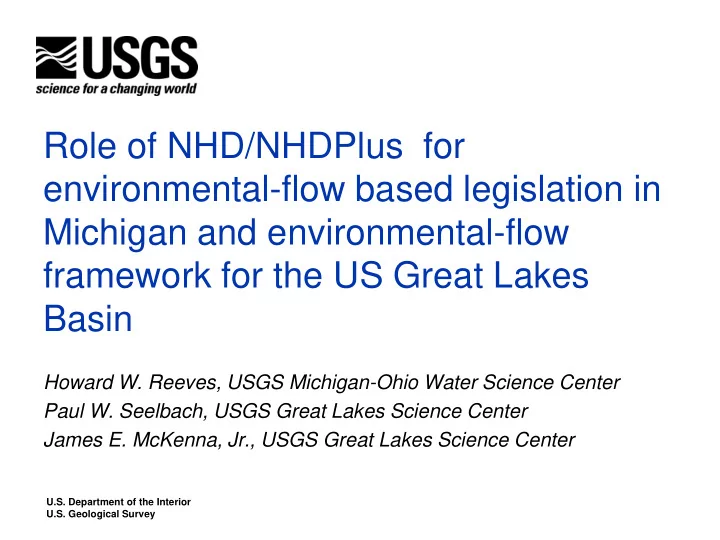

Role of NHD/NHDPlus for environmental-flow based legislation in Michigan and environmental-flow framework for the US Great Lakes Basin Howard W. Reeves, USGS Michigan-Ohio Water Science Center Paul W. Seelbach, USGS Great Lakes Science Center James E. McKenna, Jr., USGS Great Lakes Science Center U.S. Department of the Interior U.S. Geological Survey
Overview Great Lakes-St. Lawrence River Basin Water Resources Compact Interstate Compact Companion International Agreement Implemented by each state Regional goals for water conservation and efficiency Prevent adverse resource impact from new or increased water withdrawals http://www.cglslgp.org/projects/water-management/great-lakes-agreement-and-compact/
Michigan Water Withdrawal Assessment Streamflow data Fish presence and abundance Stream temperature Aquifer distribution and characteristics Steinman and others, 2011.
Role of NHD and NHDPlus NHD connectivity and catchment information: Streamflow estimates Stream temperature modeling Fish presence and abundance modeling Streamflow classification Withdrawal accounting for cumulative impact assessment
Stream Classification and Ecological Response Classification based on drainage area, stream temperature, and fish community Represents diversity in settings across the state Used to estimate impacts of withdrawal on fish communities Allows setting of thresholds Thresholds are different for different settings Set through legislative process Preserve the geography of flow
Ecological Response Curves Zorn and others, 2012
Hamilton and Seelbach, 2011
Screening Tool: Identify withdrawals less likely to cause adverse resource impacts Recognize and allow withdrawals that will likely not have adverse impacts register the use Increase efficiency and limit regulatory oversight Make system more user driven Withdrawals that do not pass screening may be submitted for site-specific review http://www.deq.state.mi.us/wwat/
Great Lakes Basin Given science components of Michigan implementation of the Compact – can we provide same information regionally? Great Lakes Restoration Initiative
Role of NHD and NHDPlus Streamflow estimates: need stream network and catchments to get landscape information for ungaged stream estimates (Luukkonen and others, 2014) Stream temperature modeling Fish presence and abundance Streamflow classification
AFINCH Analysis of Flows in Network of Channels Constrained regression technique Linear regression to estimate yield from catchments Yield * area = incremental flow from catchment Sum incremental flow down the network -> streamflow Estimates are corrected by adjusting incremental yields upstream of observed flows at streamgages Resulting estimated monthly flows match observed at active gages used in the regression step
http://cida.usgs.gov/glri/afinch/
Ecoflows Flow-Response Curves - Provisional • Period of Record 1979-2011 August median yield (cfs/mi 2 ). • Cumulative Catch-per-unit-effort versus yield is graphed • Look for areas of rapid change: population sensitive to yield • Response curves show reductions in suitable habitat with changes in flow.
All Records Provisional: for illustration only
Provisional: for illustration only
Provisional: for illustration only
Resources Hamilton, D. A., and Seelbach, P.W., 2011. Michigan’s Water Withdrawal Assessment Process and Internet Screening Tool: Michigan Department of Natural Resources, Fisheries Special Report 55, 37 p. (Also available at http://www.michigandnr.com/PUBLICATIONS/PDFS/ifr/ifrlibra/Special/Reports/sr55/SR55.pdf) Hamilton, D.A., Sorrell, R.C., and Holtschlag, D.J., 2008, A regression model for computing index flows describing the median flow for the summer month of lowest flow in Michigan: U.S. Geological Survey Scientific Investigations Report 2008–5096, 43 p. (Also available at http://pubs.usgs.gov/sir/2008/5096/.) Luukkonen, C.L., Holtschlag, D.J., Reeves, H.W., Hoard, C.J., and Fuller, L.M., 2014, Estimation of monthly water yields and flows for 1951–2012 for the United States portion of the Great Lakes Basin with AFINCH: U.S. Geological Survey Scientific Investigations Report 2014–5192, 83p, http://dx.doi.org/10.3133/sir20145192 . Reeves, H.W., Hamilton, D.A., Seelbach, P.W., and Asher, Jeremiah, 2009, Ground-water-withdrawal component of the Michigan water-withdrawal screening tool: U.S. Geological Survey Scientific Investigations Report 2009-5003, 36 p. (Also available at http://pubs.usgs.gov/sir/2009/5003/.) Reeves, H.W., 2008, STRMDEPL08—An Extended Version of STRMDEPL with Additional Analytical Solutions to Calculate Streamflow Depletion by Nearby Pumping Wells: U.S. Geological Survey Open-File Report 2008–1166, 22 p. (Also available at http://pubs.usgs.gov/of/2008/1166/.) Ruswick, Frank; Allan, Jon; Hamilton, David; and Seelbach, Paul, 2010, The Michigan Water Withdrawal Assessment Process— science and collaboration in sustaining renewable natural resources: Renewable Resources Journal, v. 26, no. 4, p. 13-18. Steinman, A.D., Nicholas, J.R., Seelbach, P.W., Allan, J.W., and Ruswick, Frank, 2011, Science as a fundamental framework for shaping policy discussions regarding the use of groundwater in the State of Michigan—a case study: Water Policy, v. 13, no. 1, p. 69-86, doi: 10.2166/wp.2010.047 Zorn, T. G., Seelbach, P. W., Rutherford, E. S., Wills, T. C., Cheng, Su-Ting, and Wiley, M. J., 2008, A landscape-scale habitat suitability model to assess effects of flow reduction on fish assemblages in Michigan streams: State of Michigan, Department of Natural Resources, Fisheries Research Report 2089, 46 p. (Also available at http://www.michigan.gov/documents/dnr/RR2089_268570_7.pdf) Zorn, Troy G., Paul W. Seelbach, and Edward S. Rutherford, 2012. A Regional-Scale Habitat Suitability Model to Assess the Effects of Flow Reduction on Fish Assemblages in Michigan Streams: Journal of the American Water Resources Association (JAWRA), 1- 25. DOI: 10.1111 ⁄ j.1752 -1688.2012.00656.x
Recommend
More recommend